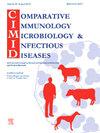新旧世界骆驼中肌囊菌的全球流行病学和物种分布比较:系统综述和荟萃分析
IF 2
3区 农林科学
Q4 IMMUNOLOGY
Comparative Immunology Microbiology and Infectious Diseases
Pub Date : 2025-04-26
DOI:10.1016/j.cimid.2025.102340
引用次数: 0
摘要
本研究旨在调查旧世界和新世界Camelids (OWCs)中Sarcocystis spp.的全球流行度、物种多样性和地理分布。在多个数据库中进行了全面的文献检索,涵盖了截至2024年12月22日的研究。该分析包括36项研究(28项关于野生骆驼,8项关于非野生骆驼),包括来自三大洲13个国家5942只骆驼(4850只野生骆驼和1092只非野生骆驼)的数据。采用随机效应模型估计合并患病率,采用I²统计量评估异质性。骆驼类中肌囊虫的总患病率为57.7% %(95% % CI: 49.4 - 65.6% %)。NWCs的总患病率(77.6% %,95 % CI: 55-90.8 %)明显高于OWCs(55.1% %,95 % CI: 46.4-63.6 %)。在南美洲观察到最高的区域合并患病率(82.3 %),特别是在世卫组织抗菌素耐药性区域(82.3 %),秘鲁报告的最高合并患病率为99.3% %。食道是最常见的感染组织。在骆驼科中鉴定出4种有效的肉囊菌,分别是在西部地区发现的cameli S.和ippeni S.,在西部地区发现的aucheniae和masoni S.。许多阳性样本仅被归类为肉囊菌属,尽管这些物种都不构成人畜共患风险,但骆驼链球菌和aucheniae等物种由于其对骆驼类的经济和兽医影响而特别重要。它们形成宏观囊肿的能力会对肉品质产生负面影响,导致骆驼产业的巨大经济损失。建议采取有针对性的监测和控制措施,特别是在高流行地区。本文章由计算机程序翻译,如有差异,请以英文原文为准。
Comparative global epidemiology and species distribution of Sarcocystis spp. in new and old world camelids: A systematic review and meta-analysis
This study aimed to investigate the global prevalence, species diversity, and geographical distribution of Sarcocystis spp. in Old World Camelids (OWCs) and New World Camelids (NWCs). A comprehensive literature search was conducted across multiple databases, covering studies up to December 22, 2024. The analysis included 36 studies (28 on OWCs and 8 on NWCs), comprising data from 5942 camelids (4850 OWCs and 1092 NWCs) across 13 countries in three continents. A random-effects model was used to estimate pooled prevalence rates, and heterogeneity was assessed using the I² statistic. The overall prevalence of Sarcocystis spp. in camelids was 57.7 % (95 % CI: 49.4–65.6 %). NWCs exhibited a significantly higher pooled prevalence (77.6 %, 95 % CI: 55–90.8 %) compared to OWCs (55.1 %, 95 % CI: 46.4–63.6 %). The highest regional pooled prevalence was observed in South America (82.3 %), particularly in the WHO AMR region (82.3 %), with Peru reporting the highest pooled prevalence at 99.3 %. The oesophagus was the most frequently infected tissue. Four valid Sarcocystis species were identified in camelids: S. cameli and S. ippeni in OWCs, and S. aucheniae and S. masoni in NWCs. Many positive samples were classified only as Sarcocystis spp. Although none of these species poses a zoonotic risk, some like S. cameli and S. aucheniae are particularly significant due to their economic and veterinary impact on camelids. Their ability to form macroscopic cysts can negatively affect meat quality, leading to considerable economic losses in the camel industry. Targeted surveillance and control measures are recommended, particularly in high-prevalence regions.
求助全文
通过发布文献求助,成功后即可免费获取论文全文。
去求助
来源期刊
CiteScore
4.60
自引率
0.00%
发文量
102
审稿时长
40 days
期刊介绍:
Comparative Immunology, Microbiology & Infectious Diseases aims to respond to the concept of "One Medicine" and to provide a venue for scientific exchange. Based on the concept of "Comparative Medicine" interdisciplinary cooperation between specialists in human and animal medicine is of mutual interest and benefit. Therefore, there is need to combine the respective interest of physicians, veterinarians and other health professionals for comparative studies relevant to either human or animal medicine .
The journal is open to subjects of common interest related to the immunology, immunopathology, microbiology, parasitology and epidemiology of human and animal infectious diseases, especially zoonotic infections, and animal models of human infectious diseases. The role of environmental factors in disease emergence is emphasized. CIMID is mainly focusing on applied veterinary and human medicine rather than on fundamental experimental research.

 求助内容:
求助内容: 应助结果提醒方式:
应助结果提醒方式:


